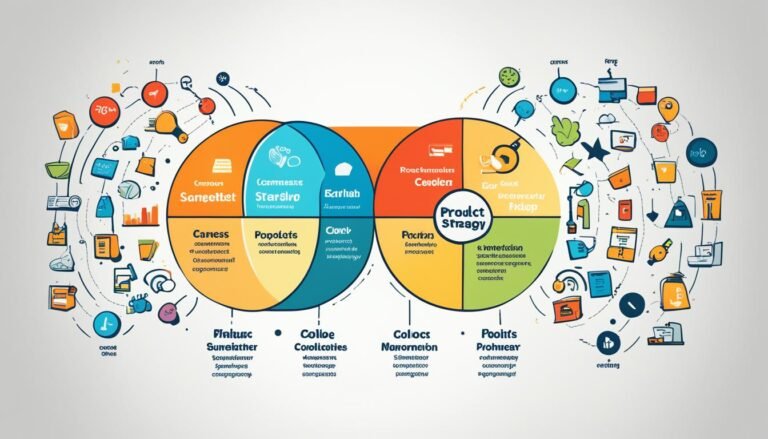The Impact of Economic Theory on Marketing
In the past decade, the number of books on behavioral economics has soared. This shows a big change in how businesses see consumer behavior and market trends.
Experts like Rana Mostaghel and Pejvak Oghazi have played a big role in linking economics with marketing. They talk about digital changes and how markets work. Their ideas help marketers make better plans by understanding how people decide based on economic theories. A study in 2018 showed that nudging people about avoiding loss made them use more electricity by 2% than others. This shows how marketing can use economic ideas to change real actions.
Key Takeaways
- The intersection of economic theory and marketing enhances understanding of consumer behavior and market dynamics.
- Behavioral economics reveals that people are influenced by their environment, past experiences, and emotions, essential for crafting effective marketing strategies.
- Payment delays as a strategy can boost sales, demonstrating practical applications of economic principles.
- A shift from the traditional “contact economy” to the “attention economy” has transformed marketing dynamics in recent years.
- Marketers should integrate data analytics and emerging technologies like AI to optimize their campaigns based on economic insights.
- Understanding price elasticity and consumer biases, such as loss aversion and projection bias, can significantly impact revenue and profitability.
- Sustainability and ethical concerns are becoming increasingly vital in developing long-term marketing strategies.
Introduction to Economic Theory in Marketing
Economic theory helps us understand how markets work and what drives consumer choices. Famous economists like Ana Lisboa have greatly improved our grasp of international marketing from an economic view. It’s key to know about supply and demand, price changes, and how consumers decide to buy things.
Overview of Economic Theory
Economic principles shed light on how markets work and decision-making by buyers and sellers. Most countries have mixed economies, blending free markets with some government control. They often produce public goods and have markets for corporate control.
The main theory taught in many schools is Neo-classical Theory. It focuses on making people happy through trading.
Relevance to Marketing
Economic principles are very important for marketing. Market supply curves show the total cost of making a certain amount of goods. This helps marketers set the best prices.
Knowing how the supply law works helps predict how prices will affect sales. Economic theory is key to understanding how buyers act, which is vital for targeting the market right.
Marketers need to understand how prices affect both buyers and the supply of goods. By simplifying these complex ideas, marketers can find effective ways to reach their audience.
Consumer Behavior Analysis
Understanding how people act when buying things is key to making marketing work. By using economic theory, marketers can see what drives people to buy. This helps them do better market research, understand what people think, and make campaigns that hit the mark.
The Role of Economic Theory
Economic theory is vital for studying how people behave when buying. For example, the idea of scarcity and fearing to lose something affects how people see products. Most of the time, people make choices without even thinking about it, showing how important it is to know what they want.
Also, certain economic rules help predict and shape what people choose to buy. This leads to better marketing campaigns.
Applications in Marketing Strategies
Using economic theory in marketing helps companies improve their plans. By learning from market research, they can make campaigns that really speak to people. For instance, making products seem scarce can make them more appealing to buyers.
Knowing what people think and feel also helps build trust with brands. Most people trust brands with lots of good reviews. And 92% look at what others think before buying something.
Today, the way people interact with brands has changed a lot thanks to the internet and mobile devices. So, marketing strategies need to adapt to keep up. This means using new tech to connect with consumers.
By keeping up with economic insights and what consumers want, marketers can make campaigns that really work. This not only makes customers happier but also helps businesses grow by offering what people really want.
Pricing Strategies Driven by Economic Insights
Economic theory helps businesses set the right prices. By understanding how price changes affect customers, companies can pick the best pricing models. This approach helps boost revenue and profits.
Understanding Price Elasticity
Price elasticity shows how much customers react to price changes. Knowing if demand is elastic or inelastic guides pricing strategies. For example, elastic demand means a small price change can lead to a big drop in sales.
Stores like Walmart and Kroger use economy pricing strategy to keep costs low. But, they also use discounts to increase sales without cutting into profits too much.
Impact on Revenue and Profitability
How companies price their products affects their earnings and profit margins. Cost-based pricing sets prices based on what it costs to make the product. This method is common when companies don’t know much about what customers want.
For instance, research by Movens Capital shows that anchor pricing can really make a difference. This method sets a standard price based on the first information customers see.
- Strategic Discounting: Stores use the framing effect to make offers look better, which can lead to more sales. Highlighting savings can make customers buy faster.
- Price Bundling and Tiered Pricing: Offering products in bundles or different prices can increase profits. Techniques like price anchoring and the decoy effect make customers choose more profitable items.
- Economy Pricing: Companies like Trader Joe’s use low prices to draw in customers. This strategy needs high sales to be profitable.
- Scarcity and Social Proof: Launching limited products or showing customer reviews can create a sense of urgency. This can influence what customers decide to buy.
It’s important for businesses to keep checking and changing their strategies. Using cost-based pricing, discounts, and other smart methods helps them stay profitable in tough markets.
Market Segmentation and Economic Theory
Market segmentation uses economic theory to help marketers understand and improve their strategies. By looking at demographic analysis, they find groups of consumers based on age, gender, income, and education. This makes targeting specific groups easier and helps use resources better.
Economic theory also looks at psychographic and socio-economic factors to make segmentation strategies more precise. For instance, the Preferred Habitat Theory shows how people prefer certain bond maturities. Banks go for short-term bonds, while insurance companies like long-term ones. This shows how people’s feelings and financial security affect niche targeting.
The Market Segmentation Theory says investors like different bond lengths, creating various market groups. These groups affect supply and demand, making yield curves unique for each type. Knowing this helps marketers make better strategies, meeting both short-term and long-term consumer needs.
Looking back at history helps us understand more about market segmentation. A study in the Journal of Marketing Research (November 1968) showed important strategies and challenges. By thinking about these, marketers can make more money by responding well to price changes. This leads to better use of segmentation.
The Importance of Demand Forecasting
Demand forecasting is key for businesses. It helps them predict sales and plan better. By using economic models and predictive analytics, companies can improve their forecasting accuracy. This is crucial for making smart decisions.
It also helps with managing inventory. This ensures businesses have the right amount of stock to meet customer needs.
Economic Models for Predicting Demand
Economic models are the core of accurate demand forecasting. They look at sales history, market trends, and other factors like seasonality and competition. Companies use various forecasting methods to get the best insights.
Accurate demand forecasts help avoid stockouts and overstocking. This leads to better inventory management.
Implications for Marketers
Demand forecasting is important for marketers too. It helps with planning, budgeting, and checking how well marketing campaigns work. Marketers can plan production, promotions, and procurement better.
This leads to better inventory levels and customer satisfaction. It also helps with seasonal changes, making sure inventory and production match demand.
Predictive analytics in demand forecasting gives insights for better decision-making. This includes supply chain and resource planning. Companies that are good at demand forecasting have an edge in the market.
Competition Analysis in Marketing
In marketing, understanding your competitors is key. It helps you see your market power and gain an edge. Economic theory says that competition makes everyone’s return on investment similar. This helps marketers see how they stack up against others.
Having a lasting edge in the market means you make more money than it costs to run your business. This is what investors look for. They want businesses that will do well over time.
There are four main reasons to study your competitors:
- Identify what makes you different.
- Learn what your competitors are good at.
- Set goals for success.
- Understand your audience better.
Take Trello, for example. It faces competition from Asana, Basecamp, and others. It also has indirect rivals like Slack and Notion. Companies like ClickUp and Airtable are changing the game too.
Stable market share is key to staying ahead. But, if it changes a lot, it can be hard to keep creating value. Experts like Bruce Greenwald have studied this for decades.
To check if a company is competitive, look at its market share and profits. This shows if it has an edge. When analyzing competitors, consider several things:
- Overview: where they are, who they target, and who buys from them.
- What they mainly offer.
- How they price things.
- Where they stand in the market.
- What customers say about them.
Understanding where competitors sit in the market helps you see your own strengths. This way, you can plan better to stay ahead.
Optimizing the Marketing Mix Through Economic Theory
Economic theory is key in making the marketing mix better. It helps decide where to spend money, makes sure promotions are cost-effective, and shapes products for the market. The marketing mix, known as the “4Ps”—product, price, place, and promotion—gains a lot from economic analysis.
Marketing mix modeling is a vital tool. It measures how marketing affects sales and business success. MarketScience uses new methods to look at long-term brand building. This approach fixes issues with last-touch performance media for a clearer view.
Using dynamic hierarchical Bayesian estimation gives deeper insights. It helps in placing products right and creating new ones. This method looks at both immediate sales and long-term brand building, capturing marketing’s full impact.
The short-term network uses a dynamic unobserved components model and AdStocks for direct response. It tackles biases like last-click attribution with nested sub-models. The long-term network uses a brand-building Vector Error Correction Model (VECM). This model links long-term preferences to base sales.
Econometric methods are crucial for marketing mix modeling. They started in the early 1900s with work by economists like Ragnar Frisch and Jan Tinbergen. Now, they help marketers predict what customers will do, set the right prices, and use ads wisely.
Advanced econometric models look at trends, seasonality, and cycles in sales. This helps in planning strategies based on market trends. They also simulate market scenarios by using competitor data, giving a detailed view of the market.
Econometrics also figures out Customer Lifetime Value (CLV) by looking at churn rate and purchase frequency. These models are used in web analytics too. They help understand customer journeys and how online reviews affect sales.
Marketing Mix Modeling (MMM) started in 1953 by Neil Borden. It’s a key method to see how marketing channels affect sales and customer engagement. It helps answer big questions about the best marketing spend, channel ROI, and how marketing budgets affect sales. Using offline data is a big plus of MMM, giving a full view of marketing impacts.
These models adapt to market changes and use real-time data. Data normalization is key, making data consistent and reliable. Regression analysis is also crucial. It shows how marketing activities affect sales and ROI, looking at both cause and effect.
Decision Theory Applications in Marketing
Decision theory helps us understand why people make choices. It’s studied in many fields like business, economics, and political science. For marketers, it’s key to predict what customers will do and make smart choices.
Rational Decision-Making Models
Rational decision-making models are based on two theories: Normative and Optimal Decision Theory. These models study how decisions turn out and why people choose certain options. They look at different kinds of uncertainty, like states, consequences, and actions.
Knowing these models helps marketers better understand how customers make choices. They consider things like getting the most value from a purchase. For example, a theory from 1736 helps us see how people feel about risk and choose the best action based on what we know.
Behavioral Economics Insights
Behavioral economics shows us how our minds can trick us when making choices. These tricks can make us act differently than we should. By understanding these biases, marketers can make better guesses about what customers will do. This helps them plan their ads better.
There are different ways people feel about risk, like being risk lovers, neutral, or averse. Risk-averse people often pick safe choices, even if they don’t get as much return. By knowing this, businesses can tailor their marketing to reach more customers and help them make the best choices.
Game Theory in Marketing
Game theory helps marketers understand how people act in different situations. It lets them predict what customers will do and plan better strategies. By knowing about Nash equilibria and the prisoner’s dilemma, companies can handle complex situations like fighting for market share and making alliances.
Strategic Interactions and Market Behavior
Businesses use game theory to study how they compete and what might happen next. The Nash equilibrium is key. It means no one can do better on their own. This helps companies plan the best moves, thinking ahead of what others might do.
This is very useful in real marketing challenges, like competing in the market at the same time.
Applications of Game Theory in Competitive Strategies
Game theory is a big part of business, including marketing. It helps with planning campaigns, auction strategies, and prices. For instance, during Black Friday sales, companies set prices using game theory to balance demand and competition.
Strategic alliances are also planned with game theory to improve market position and engage customers better. The prisoner’s dilemma shows how working together can lead to better results. This helps businesses win in market share battles.
Conclusion
Economic theory deeply affects marketing, playing a key role in understanding and predicting its outcomes. By using economic ideas, marketers can better handle the complex market forces. This makes their strategies more precise and effective.
Looking at how people act and setting prices smartly are just two ways economic theory helps in marketing. Countries like the United States, Germany, and Canada show how government actions and market forces can work together. This helps both businesses and customers.
Knowing about different economic models is crucial for predicting what people will want and for targeting the right markets. Tools like game theory and decision theory are also very useful. They help in analyzing competition and making smart choices.
Putting economic ideas into marketing strategies leads to better decisions and successful campaigns. This shows how important economic influence is in marketing’s changing world.
Source Links
- The Origin of Behavioral Economics and its Influence on Marketers and Consumers – Michigan Journal of Economics
- Connecting Economics, Marketing Theories, and the Attention Economy
- What Is a Market Economy and How Does It Work?
- Chapter 1. Introduction to Economics
- 9 Eye-Opening Examples Of Behavioural Economics Marketing
- Maximizing Revenue: Behavioral Economics In Pricing Strategies
- Economy Pricing Strategy: What You Need to Know
- Behavioral Economics and its Influence on Market Analysis
- What Is Market Segmentation Theory? Definition and How It Works
- A Theory of Market Segmentation
- How to Forecast Customer Demand: Methods & Benefits
- Benefits of Demand Forecasting: A Guide to Implementation
- What is a Competitive Analysis — and How Do You Conduct One?
- Dynamic Marketing Mix Modeling
- Marketing Mix Modeling: Econometrics in Practice
- Everything you need to know about Marketing Mix Modeling – Adsmurai
- Decision Theory
- Applying Decision Theory Economics to Improve Sales Forecasting
- Game Theory: A Comprehensive Guide
- How Is Game Theory Useful in Business?
- What is Market Economy? | Types, Theory, Advantages, Disadvantages
- A Brief Note on the Theory of Market







